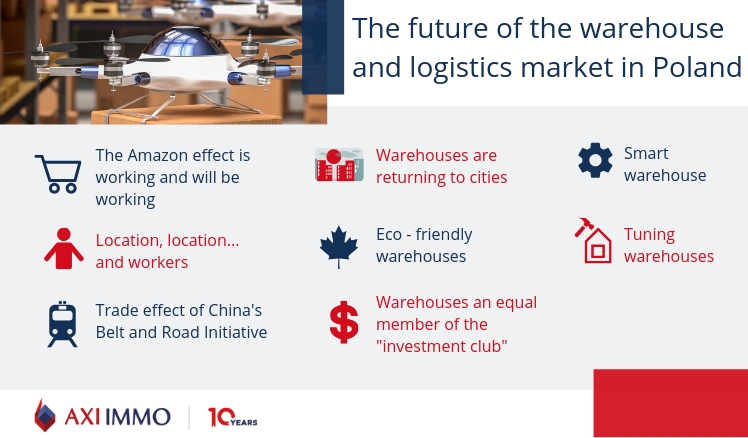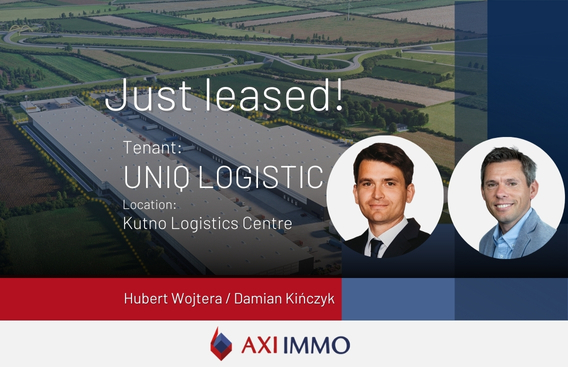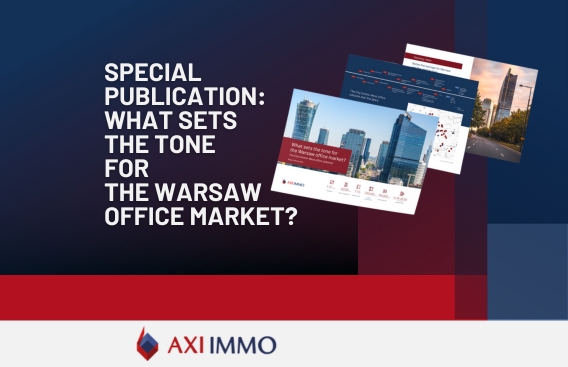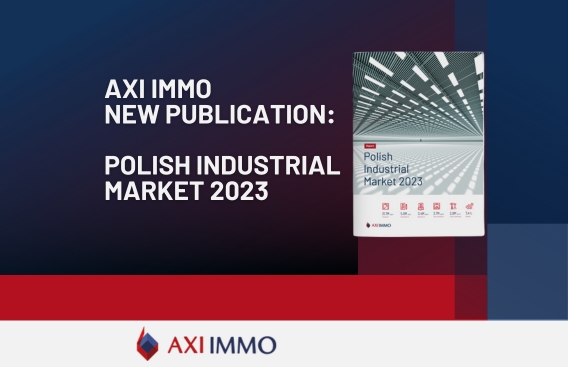Report: The future of the warehouse and logistics market in Poland
The warehouse and logistics market has had another period of stable growth. AXI IMMO experts indicate trends in the warehouse market, which will be crucial for this sector in Poland.

The warehouse market in Poland has had another stable period of growth on the demand and supply side. In what direction will the sector develop, what will determine its further growth, and what factors will be the obstacle? AXI IMMO experts selected market trends that will be crucial for the warehouse sector in Poland in the coming years.
| Download report: | Report – The future of the warehouse and logistics market in Poland | Download for free: PDF | 321 KB |
The Amazon effect is working and will be working
E-commerce is changing the warehouse and logistics market on a global scale. We are seeing the use of the online sales channel in all areas related to consumption. According to data from Digital Market Outlook Statista (Source: Digital Market Statista: Worldwide e-commerce revenue forecast 2017 – 2023 in US dollars), the total value of the e-commerce market globally grew by 15 per cent last year, what gave amount USD 1.78 trillion spend for online shopping. 1.8 billion people around the world shop online, while in Poland the figure is about 15 million, and that number is constantly growing. The value of e-commerce in Poland in 2018 was over PLN 40 billion, and by 2020 it will exceed PLN 70 billion (Source: Report Gemius „E-commerce in Poland 2017 and 2018″).
The new style of consumption means that almost all trends in the warehouse sector are related to adapting the product and logistics operations to the needs of this demanding sector. The standards of warehouse space are changing on our eyes, supply chains, consumer service and the digitisation of warehouse and logistics processes are undergoing a transformation.
Warehouses are returning to cities
Growing consumer expectations will require a further transformation of supply chains, which will result in increased demand for urban projects in order to effectively provide next-day or same-day delivery. A challenge for developers will be the availability of investment land in cities and their outskirts, especially since recent years have seen the sector progressively leave cities and industrial areas have been earmarked for housing, offices and commercial facilities. However, in the case of large companies, we will continue to see supra-regional distribution hubs being built, but supported by a network of suburban supply centres.
Smart warehouse
Unconventional tools supporting warehouse services and product delivery will evolve. Today, drones delivering packages and autonomous cars are technological gimmicks that are still at the testing stage in Poland; however, the market is heading in this direction.
Smart warehouses will also use various software tools, which, along with a combination of technology and people using applications, sensors and wireless communication, the efficiency in managing products in terms of price, time and space will increase.
The value of the automation tools market is expected to reach USD 149 billion in 2020, and by 2024 it will increase up to USD 321 billion (Source: Data based on research by US Zion Market Research 2018).
Location, location and … workers
The lowest rate of unemployment in 25 years of 5.8%, recorded at the end of December 2018 (Source: Statistics Poland Centre, January 2019), combined with low rates of professional activity, an aging population and a low retirement age, means that in the coming years the ability to recruit employees will be crucial especially for production and e-commerce companies. Therefore, from the point of view of tenants and investors, the location of storage facilities along the main motorway routes will be still important, but not the first priority. A key factor will be the availability of staff. We will observe further development of location in past voivodship cities.
Tuning warehouses
The declining supply of land, growing rental rates, limited staff availability and the associated progressive process of robotisation and automation of warehouse operations will affect the technical requirements of the warehouse and logistics facilities being built. The 10-metre height standard will become a thing of the past. Tenants with individually designed processes will expect developers to provide space with increased energy supply, floors designed for robots and roof-gardens for employees.
Eco-friendly warehouse
Increasing utility costs and the pro-environment strategies of many tenants are changing warehouse energy requirements. The LED lighting and better-insulated walls are already being introduced, the next step is photovoltaics and even more efficient utility management systems. Certification of facilities, similar to the office sector, will become a market standard.
Trade effect of China’s Belt and Road Initiative
Belt and Road Initiative is the strategic project for the Chinese government but at the beginning stage.
Currently, 90% of Asian cargoes are delivered to Europe by sea, but the import of goods by rail from China has more than doubled in five years and continues to grow, similarly to exports to Asia. Every year, 30 tons of goods are transported from Poland to China by rail. This is a modest result, but the growth potential in the following years is large.
Due to its geographical location, Poland has a chance to become a bridge connecting western markets with Central Asia, the issue that is hindered by administrative procedures, lack of infrastructure and failure of existing transhipment terminals.
Warehouses an equal member of the ‘investment club’
In the next few years, interest in warehouse products among investors will grow. The Polish warehouse market, thanks to the development of online sales, competitive rental rates and a location at the intersection of the most important transport routes in Europe and Asia, has a stable basis for growth. In addition, the market is increasingly mature, resulting in changes in lease structures, where contracts for 5 years and more are beginning to dominate. Large flows of Asian capital are coming to the CEE region and Poland, the first effects of which are already visible. More than 20% of the warehouse space market in Poland belongs to funds with Asian capital. Warehouse products after many years are assessed as equally valuable as office and retail investments.
Read about the trends in the office market in Warsaw.
Recent articles

15 April 2024
UNIQ LOGISTIC stays in Kutno, AXI IMMO real estate agency advises
UNIQ LOGISTIC stays in Kutno, central Poland, in the Kutno Logistics Centre. The tenant was advised by AXI IMMO

27 March 2024
MR D.I.Y. advised by AXI IMMO rents a warehouse at Hillwood Zgierz I, Central Poland
Almost 5,000 sq m for the logistics headquarters of MR D.I.Y. in Central Poland

26 March 2024
Warsaw’s Bliska Wola as a model example of a modern office district
AXI IMMO, the largest Polish real estate agency on the commercial real estate market, presents a special publication "What sets the tone for the Warsaw office market?"

12 March 2024
The latest AXI IMMO report: Industrial Market in Poland 2023
The Industrial market in Poland in 2023 – slower, but not weaker